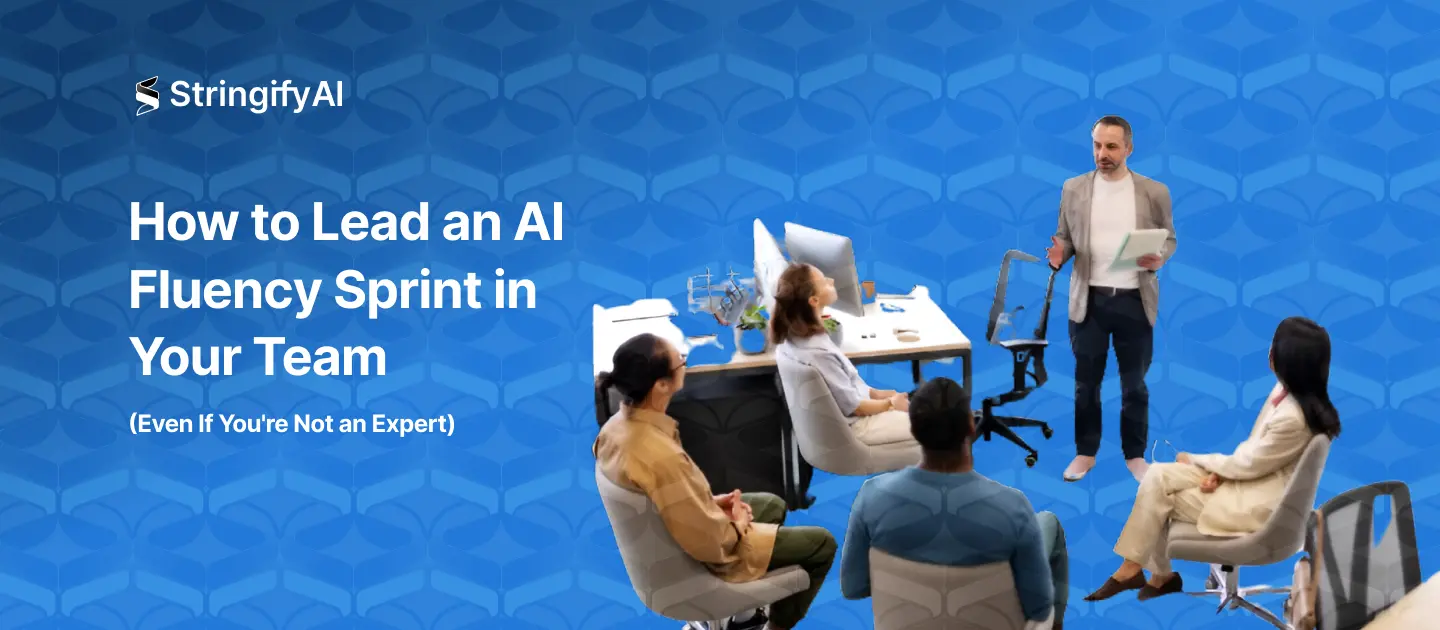How to Lead an AI Fluency Sprint in Your Team (Even If You're Not an Expert)
You don’t need to be an AI guru to lead change. You just need to make curiosity contagious.
🧭 Why a Fluency Sprint Works
Most AI upskilling programs fail because they assume knowledge precedes action. In reality, people need a safe space to play, experiment, and reflect—before they can build true fluency.That’s where a 5-day AI Curiosity Sprint comes in.
It’s:
- 🧪 Low-risk — No tools to install, no technical knowledge required
- ⏳ Time-bounded — 20 minutes a day for 5 days
- 🤝 Social by design — Encourages peer learning and confidence-building
You’re not training experts.
You’re unlocking behavior.
🛠️ The Sprint Structure (5 Days)
Each day focuses on one habit of AI fluency. Here's how to run it in a team:
📅 Day 1: Setup & Exploration
Goal: Break the ice with playful, open-ended prompting
- Pick a tool (e.g. ChatGPT, Claude, Gemini, Perplexity)
- Ask 3–5 playful prompts:
- “Write a haiku about our product roadmap”
- “What would Steve Jobs say about our brand tone?”
- “Explain our mission like I’m five”
- Share the most surprising output in a team thread or Slack channel.
🧠 Why it matters: Reduces intimidation. Builds shared delight.
📅 Day 2: Use It for a Real Task
Goal: Experience practical value
- Choose a daily task you already do:
- Drafting an email
- Summarizing a meeting
- Rewriting a Slack update for clarity
- Use AI to assist, then compare your old and new versions
- Post 1 thing that worked better with AI
🧠 Why it matters: Creates immediate relevance and small wins.
📅 Day 3: Compare Prompts
Goal: Develop prompt awareness and mental models
- Take one task (e.g. summarizing a blog post)
- Try 3 different prompts:
- “Summarize this in 3 bullet points”
- “Make this into an inspiring LinkedIn post”
- “Turn this into a persuasive memo for my boss”
- Reflect: What changed? What worked best?
🧠 Why it matters: Builds intuition through contrast and iteration.
📅 Day 4: Teach One, Learn One
Goal: Spread peer learning and normalize experimentation
- Pair up with a teammate
- Share:
- Your favorite prompt or trick
- One task you found AI helpful for
- Bonus: Create a shared team doc of “Prompt Recipes”
🧠 Why it matters: Teaching reinforces learning. Curiosity becomes cultural.
📅 Day 5: Reflect & Plan
Goal: Internalize the shift and identify next steps
- Ask:
- What surprised me this week?
- What will I continue doing?
- What task might I try next?
- Bonus: Run a “prompt jam” lunch session the following week
🧠 Why it matters: Reflection locks in habit change. Momentum builds fluency.
🎯 Tips for Team Leaders
Even if you’re not AI-savvy, you can guide this sprint. Here's how:
Model vulnerability
Share what you don’t know.
Celebrate exploration
Applaud fun and weird uses, not just polished outcomes.
Create visibility
Use a shared thread or doc to capture team learnings.
Give permission
Block 20 minutes/day on calendars during sprint week.
Remember: This isn’t about doing more.
It’s about learning differently
💬 What Success Looks Like
After a sprint, you might hear:
- “I didn’t know I could use ChatGPT like that…”
- “I tried something new with a client proposal”
- “We built a team prompt guide in Notion”
- “I finally get how to shape the output I want”
That’s fluency. Not just knowledge—confidence in motion.
🚀 TL;DR: Sprint Checklist
| ✅ | Step |
|---|---|
| 👾 | Day 1: Play with prompts |
| ✉️ | Day 2: Apply to real work |
| 🔁 | Day 3: Compare outputs |
| 👥 | Day 4: Teach and swap tricks |
| 🧭 | Day 5: Reflect and plan forward |
🔁 Want to Make It Stick?
Once the sprint ends, extend the behavior:
- 📓 Start a shared “Prompt Bank” in Notion or Google Docs
- 🧠 Rotate monthly “Prompt Jam” sessions
- 📈 Track team use cases and wins as fluency metrics
- 🎉 Reward the most curious, not just the most polished
In the next post, we’ll explore the mental model shift that makes these behaviors sustainable:
✅ Why the real transformation isn’t skill-based—it’s mindset-based
